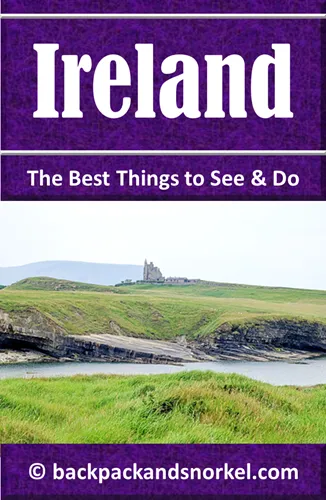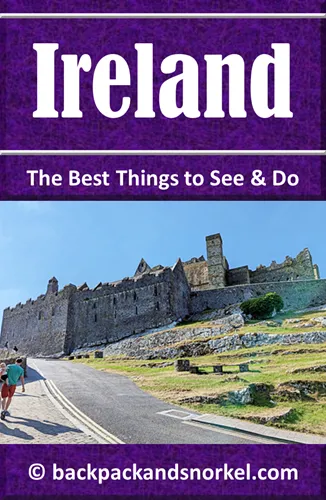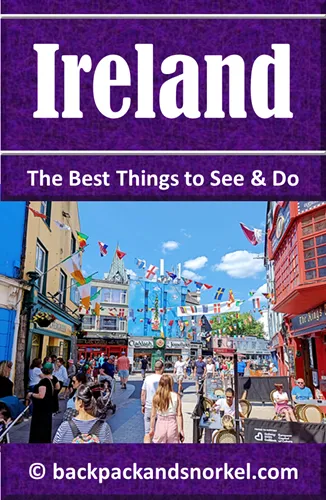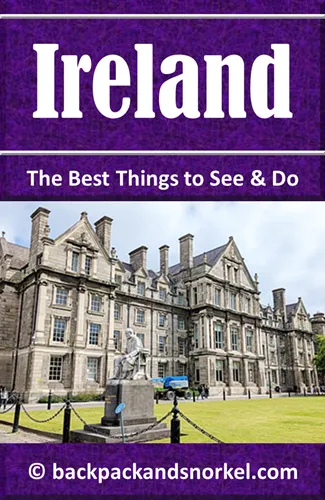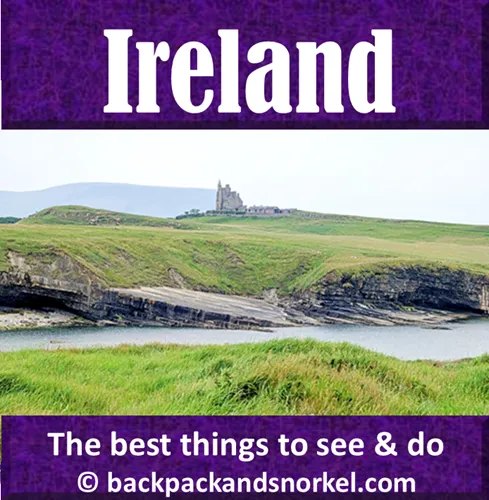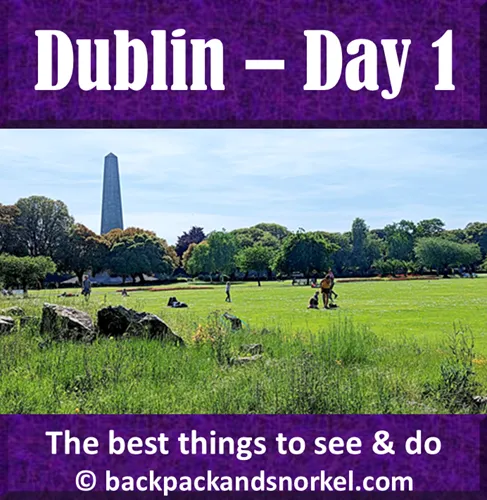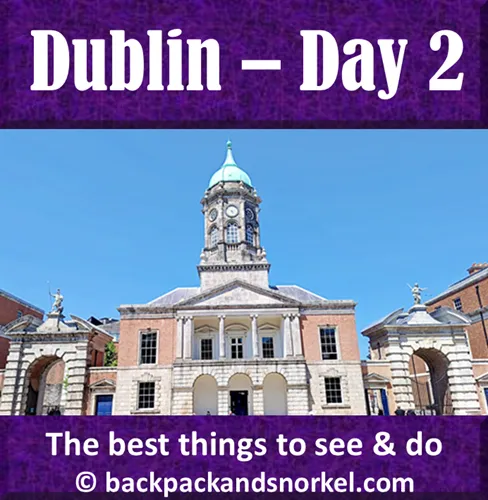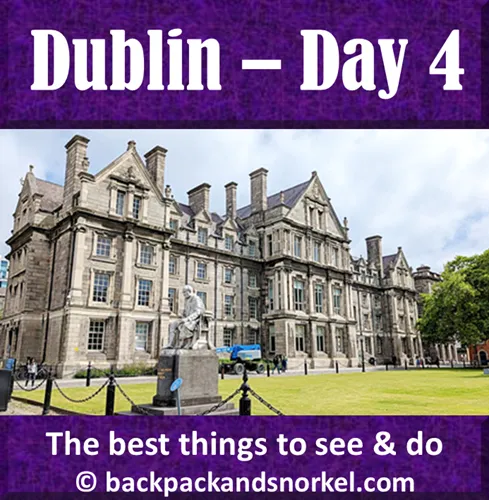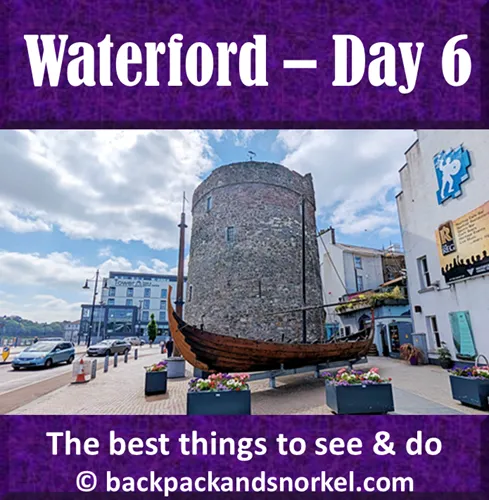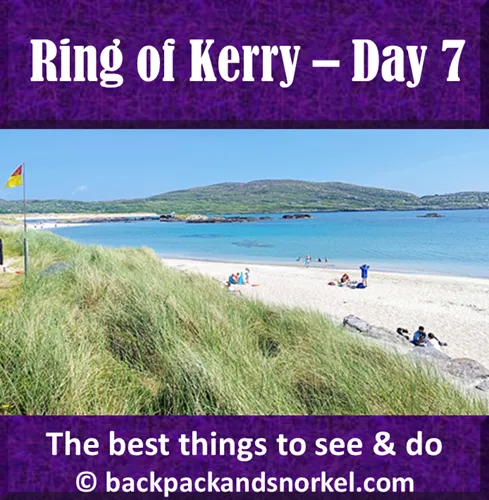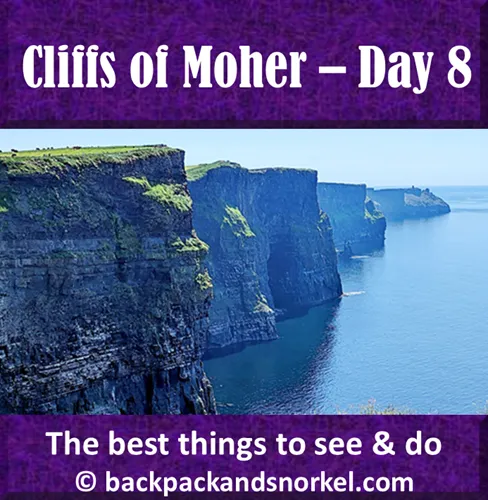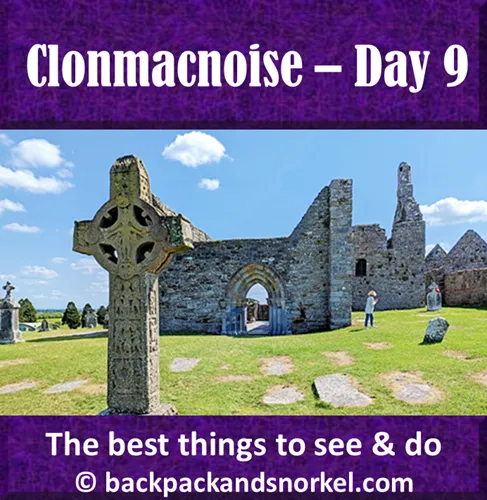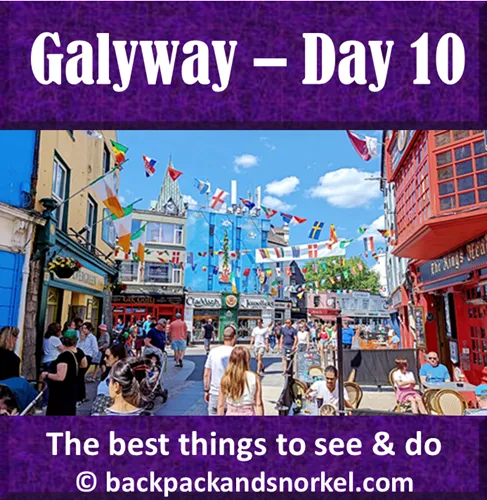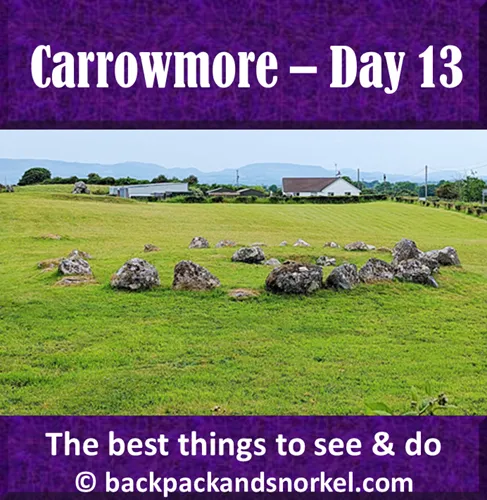Travel Guide for Powerscourt House & Gardens, Glendalough Monastic Site, Rock of Cashel, and Hore Abbey - Backpack and Snorkel Ireland Purple Travel Guide
Today we will see the highlights between Dublin and Kilkenny: Powerscourt House & Gardens, Glendalough Monastic Site, Rock of Cashel, and Hore Abbey. We provide detailed information and the best things to see and we show lots of photos so you know what you can expect.
Today is a long day and you need to make sure to arrive at the Rock of Cashel before it closes. So, please get up early so that you arrive at your first destination, Powerscourt House & Gardens, at 9:30am.

1 = Dublin
2 = Powerscourt House & Gardens
3 = Glendalough monastic site
4 = Rock of Cashel
5 = Hore Abbey
6 = Kilkenny
Kilkenny is a small town with a population of a little over 27,000 and a popular tourist attraction. The name comes from the Irish ‘Cill Chainnigh’, meaning 'church of Cainnech’, from Saint Canice or Cainnech of Aghaboe.
A Christian church and settlement here (now St. Canice's Cathedral) dates back to early 6th century during the Kingdom of Ossory.
After the Normans conquered Ireland in the 12th century, they built Kilkenny Castle, several other fortifications, and gave Kilkenny a charter as a town in 1207.
In 1609, King James I of England granted Kilkenny the Royal Charter, making it officially a city.
Starting in the late 17th century, Kilkenny became a center of brewing beer. Even nowadays, there are still a number of breweries in the area.
Table of contents
Powerscourt House & Gardens
Powerscourt Estate is a 47-acre (19 hectares) country estate that is famous for its mansion and landscaped gardens.
It was listed in the ‘Top Ten Houses in the World’ by Lonely Planet in 2011, and in 2014, National Geographic ranked it number 3 on their ‘World's Top Ten Gardens’ list.
Built as a castle in the 13th-century by Anglo-Norman nobleman Baron La Poer, which was later anglicized to ‘Power’, the original house had 3 stories and 68 rooms. A mile-long avenue of beech trees led to the mansion.
The location of the castle was chosen as it was possible to control access to the nearby Dargle, Glencree and Glencullen rivers from here.
In the 16th century the Powerscourt family bought the house, and their heirs hired one of the greatest Irish architects of the 18th century to remodel the medieval castle and convert it into a modern country house. This work took place from 1731 to 1741.
King George IV stayed here in 1821.
The gardens were added from 1844 – 1880 and were inspired by the Palace of Versailles (France), Schönbrunn Palace (Vienna, Austria), and Schwetzingen Castle (Heidelberg, Germany).
In 1961, the Powerscourt family sold the estate to the Slazenger family, who currently owns it.
The house was largely destroyed by fire in 1974 and it took until 1996 to finish the renovation. Today, only two rooms have been restored to how they used to look and are open to the public. The rest of the house is used for special events and cannot be visited.
The gardens, however, are totally worth a visit.
At the time of writing, Powerscourt is open all year except for Christmas from 9:30am until 4:30pm or 5:30pm. Depending on the month. Admission is €9 per adult and €7 per adult for the waterfall which is located 4.5 miles (7 km) away from the house.
Plan 60 - 120 min to tour the gardens. Their website shows a 60 min walking tour that brings you to the highlights:
- Tower Valley with the Pepperpot Tower
- Japanese Gardens from 1908
- Triton Lake with a fountain that is based on the fountain in Piazza Barberini in Rome
- Italian Garden
- one of Ireland’ largest private pet cemeteries
- Dolphin Pond from late 19th century Paris
- Walled Garden


Glendalough monastic site
History of Glendalough monastic site
The Glendalough monastic site was founded by St. Kevin in the early 6th century and named one of two dioceses of North Leinster at the Synod of Rath Breasail in 1111.
The Book of Glendalough, a medieval Irish manuscript which ranks as one of the three major surviving Irish manuscripts from pre-Norman Ireland, was written there about 1131.
In 1214, the diocese of Glendalough is integrated into the diocese of Dublin and starts diminishing in importance.
In 1398, English forces destroy the settlement, leaving Glendalough’s church only of local importance and a place of pilgrimage for St. Kevin.
Today, only remnants of a few buildings remain – they are likely from the 10th and 12th centuries.
Visiting Glendalough monastic site
Glendalough has two sites. The main monastic site is near the lower car park and the Wicklow Mountains historic places near the upper car park, which also has hiking opportunities on 9 trails.
Parking at the Glendalough monastic site near the lower car park
You can either park at the Lower Car Park and pay the €4 parking fee, which gives you free admission to the Visitor Centre, or you can try your luck directly near the entrance to the monastic site where the street vendors are. This tiny parking area is free and it has space for up to 10 cars, depending on how many street vendors there are. It is located near a private entrance, so please don’t block the gate. If you are lucky enough to park there, then you will need to pay €4 to access the Visitor Centre.
If you need restrooms, they are located between the Visitor Centre and the Glendalough Hotel.
Things to see at the Glendalough monastic site near the lower car park

1 = The Gateway
2 = Glendalough Cathedral
3 = The Priest's House
4 = St. Kevin's Church
5 = Deer Stone
6 = Glendalough Round Tower
7 = St. Marys Church
Tombstones
1. The Gateway
The double gateway is the entrance to the Glendalough monastic site.
The two granite arches were originally likely part of a two-story building that was built between 900 and 1200. It likely had a timber roof and looked like a tower. On the west wall between the two arches you can see is a cross carved into a stone.
The arches were part of a wall encircling the monastic site, but very little is left of it.


2. Glendalough Cathedral or St. Peter and St. Pauls' Cathedral
The cathedral, St. Peter and St. Pauls, is the largest church at the Glendalough site and one of the largest known early Christian churches in Ireland.
It ceased to be a cathedral in 1214, when the diocese of Glendalough was integrated into the diocese of Dublin.
The earliest part of the church is the nave which may date back to the 10th century. The finely decorated chancel is likely from the 12th century and it contains a mediaeval and early Christian gravestones. The date of the large monolithic St. Kevin’s Cross is uncertain.


3. The Priest's House
The original Priest’s House was likely an oratory or shrine that was built in the 12th century. It gets its name because priests were interred here in the 18th and 19th centuries.
What you see today is a reconstruction from a 1779 sketch using the original stones.

4. St. Kevin's Church
St. Kevin's Church originally only had a nave, an entrance in the western wall, and a small round-headed window in the east gable. The chancel and the sacristy were added later. The steep roof is made of overlapping stones and supported internally by a semi-circular vault.
The roof chamber could be accessed through a rectangular opening in the western end of the vault.
Its round tower on the western end is the bell tower. With its conical cap and four small windows it resembles a kitchen chimney and sometimes called St. Kevin's Kitchen, but no food was cooked here.


5. Deer Stone
The Deer Stone is a bullaun stone – a bullaun stone is a stone with a large divot or cup-shaped hole that was either manmade or created through erosion.
Such stones were found throughout Glendalough monastic site and its original use is unknown - it may have been used for food preparation or metal production in the past.
Over time, these stones were associated with pilgrimages and the water that accumulated in them was thought to have healing abilities.
The Deer Stone gets its name from a legend: A local man’s wife passed when she was giving birth to twins. After her death, their father asked St. Kevin for help. St. Kevin prayed and God sent a doe to the Deer Stone which then filled with milk for the twins every day.
The photo below was taken before the stone was vandalized in August 2023, which led to the formation of 4 cracks.

6. Glendalough Round Tower
The Round Tower is a 100 ft (30 m) tall, six story belltower built of mica-slate interspersed with granite likely between 900 and 1200. The six stories were connected by ladders. The top floor has four windows facing North, East, South and West, while the 3rd through 5th floor have one window each for illumination. The Round Tower’s entrance is almost 12 ft (3.5 m) above the ground, and was presumably reached with a movable ladder. In case of an attack, the ladder could be pulled inside the tower to prevent enemies from entering the tower.
The roof was rebuilt in 1876 using the original stones.

7. St. Marys Church
Directly west of the main site lies St. Marys Church. It is one of the earliest churches on the site. It has a nave and a chancel that was later added. The granite west doorway comprises a lintel which is inscribed with an unusual x-shaped cross.
The round-headed east window has two very worn carved heads on the outside.
Tombstones
The site is filled with tombstones in all shaped and sizes from various centuries.


Our proposal is to head to the Rock of Cashel, which is your next destination, and to skip the upper car park area.
In case that you have plenty of time, you may want to spend another half day at the upper Glendalough site.
Parking at the Glendalough monastic site near the upper car park
The Upper Car Park is also the parking lot for the Wicklow Mountains National Park.
Things to see at the Glendalough monastic site near the upper car park
Reefert Church
Nave-and-chancel church with a granite doorway with sloping jambs, and a flat lintel from around 1100.
The name comes from Righ Fearta = the burial place of the kings.
East of the church there are two crosses, one has an elaborate interlace pattern.
St. Kevin's Cell
Only the foundations have survived. This 12 ft (3.6 m) diameter structure had 3 ft (0.9 m) thick walls and a doorway on the east side.
St. Kevin's Bed
About 17 ft (8 m) above the water level of the Upper Lake is a cave that is almost 7 ft (2 m) deep. It is partly man-made and may have served as a retreat for St. Kevin and later for St. Laurence O'Toole.
The Caher
A stone-walled circular enclosure near the Visitor Center that has a diameter of 66 ft (20 m) is of unknown date and function.
Wicklow Mountains National Park
There are 9 trails – the short Spinc walk (5.5km / 2 hours) and a long Spinc Walk (9.5km / 3.5 hours) are challenging hikes that take you around the Glendalough Upper Lake and provide fantastic views on the beautiful scenery of the Wicklow Mountains.
The trail brings you to an abandoned Miner’s Village from the 1800s.
Rock of Cashel
The Rock of Cashel is a solitary hill of stratified limestone in the mostly flat Golden Vale.
Legend says that, when St. Patrick banished Satan from a cave, the Rock of Cashel landed here from the Devil's Bit Mountain, which lies about 20 miles (30 km) north of Cashel.
The capital city of the Eóganachta dynasty was founded here in the 5th century. It was the traditional seat of the kings of Munster until the Norman invasion.
In 1101, the King of Munster donated the fortress to the bishop of Limerick.
Most buildings on the Rock of Cashel were built in the 12th and 13th century, very little is left of the original buildings.
The oldest structure is the round tower, which is 92 ft (28 m) tall, and was built around 1100.
The cathedral was built between 1235 and 1270 as a single nave building without support columns for the roof.
The chapel of King Cormac Mac Carthaigh (Cormac's Chapel) was built from 1127 - 1134, with the help of two German carpenters that were sent by the Irish Abbot of Regensburg, Germany. The two towers on either side of the nave and chancel show their German influence. The chapel contains the oldest stairs in Ireland. The sandstone that was primarily used for the construction of the chapel has been significantly damaged by moisture. To save its frescoes, extensive restoration and preservation work is being done and dehumidifiers are installed to dry out the stone. The chapel is only open for limited guided tours and you should call ahead to understand when those tours are.
In 1647 during the Irish Confederate Wars, English troops looted and destroyed Cashel and massacred the Irish Confederate troops and Catholic clergy.
The cathedral roof was destroyed during or after the mid-1730s.
At the time of writing, admission into the buildings is from 9am until 4:45pm (mid-March – mid-October) and 3:45pm (mid-October – mid-March) and the last admission for guided tours of Cormac’s Chapel is 2:30pm.
Admission is €8 per adult.




Hore Abbey
From the Rock of Cashel, you can either walk to Hore Abbey or take a short drive. Please be advised that there is no designated parking spot at Hore Abbey. You can squeeze your car into the small spot by the entrance, if there is no other car doing that already.
Hore Abbey are the ruins of a monastery that was given to the Order of Cistercians in 1270 by Archbishop David Mac Cerbaill, who is buried here, after evicting the Benedictines that originally built Hore Abbey.
The Cistercians are an order that branched off from the Benedictines, but still follows the Rule of Saint Benedict.
In 1540 the monastery was dissolved and given to the Butler family, who also owned Kilkenny Castle.
Hore Abbey is the only Irish Cistercian monastery that has the cloister in the north of the structure.
It is believed that the word Hore comes from the word Iubhair, which means yew tree (a slow-growing and very long-lived needle tree).
Hore Abbey is open 24/7 and there is no admission fee. Chances are that you will be there all by yourself or maybe share the place with 2 or 3 other visitors.




Self-guided tour of downtown Kilkenny
When you arrive back in Kilkenny, it will likely be after 5pm or even 6pm, and most attractions stores will be closed.
Nevertheless, you should take the opportunity to explore Kilkenny’s old downtown area.
The following self-guided walking tour brings you to some of the other highlights of one of Ireland’s most historic towns.

1 = St. John's Bridge
2 = Statues Kilkenny
3 = High Street
4 = Market Cross Shopping Centre
5 = St. Mary’s Cathedral
6 = Black Abbey
7 = St Kieran’s Street
8 = Dunnes Stores
A = Kilkenny Castle
1. St. John's Bridge
Start your walking tour of historic downtown Kilkenny at St. John's Bridge, which is only a short 560 ft (170 m) walk from Langtons Hotel Kilkenny, where you may be staying.
It is believed that a bridge existed at this location since before the Norman conquest of Ireland in the 11th century. A bridge named after named after St. John’s Priory built here after 1200. The bridge was rebuilt many times over the centuries.
One particular example was after a terrible flood in 1763, where more than 100 people gathered on the bridge to see the flood waters with wreckage from the village flow down the river. At one time a whole cabin floated by and all but 16 spectators rushed to the bank to see it. Shortly after, the bridge collapsed and all 16 died.
The bridge you see today was completed in 1910. At that time it was the longest single-span reinforced bridge in Ireland and England.
From the bridge, you have wonderful views of the River Nore and Kilkenny Castle (A).


If you like you can take a walk on John’s Quay Road by Matt The Millers Bar & Restaurant that branches off to the north on the eastern side of the river.
2. Statues Kilkenny
Near the entrance to Canal Square stands a statue that is dedicated to Hurling, which is a men’s outdoor team game of ancient Gaelic Irish origin. This sport was first referenced in the 5th century and is still being played today.

If you feel like it, you can follow the paved path from the square to the south-east along the river. This path is called Canal Walk.
3. High Street
High Street is a beautiful street with lots of shops and bars. Most will be closed when you go there.


While you walk north on High Street you will pass The Tholsel or City Hall, which stands here since 1579, replacing an older Tholsel from the 14th century. At the Tholsel, The Primus Kilkenniensis = First Book of Kilkenny is stored. It incorporates the charter of Kilkenny from the early 13th century, but was printed in the late 14th century.

4. Market Cross Shopping Centre
Market Cross Shopping Centre is a shopping mall with over 40 shops on three levels, and parking space for over 500 cars.
The mall is open 7 days a week and late on Thursdays and Fridays. It has multiple entrances, but we particularly liked the entrance to the left at this particular location with its colorful hanging umbrellas.

5. St. Mary’s Cathedral
St. Mary’s Cathedral is the cathedral of the Roman Catholic Diocese of Ossory. It was built on the highest point in Kilkenny from 1843 to 1857 in a cross-shaped layout in Early English Gothic design.

6. Black Abbey
Black Abbey of Kilkenny is a Catholic priory of the Dominican Order. Established in 1225 as one of the first houses of the Dominican Order in Ireland, it is dedicated to the Holy and Undivided Trinity.
The abbey was built outside the city walls of the two towns that eventually formed Kilkenny to show its independence. The two towns were divided by the Bregach River into an indigenous Irishtown and a part settled by the English (Normans). This symbolic act, however, came with its disadvantages as the specific location was subject to annual flooding.
The abbey is called Black Abbey, because Dominicans were called Black Friars and this name comes from the black cloak which Dominicans wear.
In 1349, the abbey and its community were hit by the bubonic plague (Black Death) and in 1558 the abbey was confiscated by the protestant English Queen Elizabeth I. Under her successor, James I, the abbey was converted into a courthouse and the Dominicans evicted.
From 1642 to 1649, the Black Abbey hosted the Catholic Irish Catholic Confederation, but was overthrown by Oliver Cromwell who besieged and conquered the city in 1650.
When Catholic king James II ruled from 1685 to 1689, the abbey flourished, but in 1690, Protestant king William III seized the abbey once again.
In 1776, the Dominicans rented the abbey and in 1816 they took possession and restored as a Dominican priory. It took until Trinity Sunday in 1864 that Black Abbey was reconsecrated.

7. St Kieran’s Street
Now walk back to High Street and take the pedestrian street St Kieran’s St that branches off High Street.
The street has several murals and pubs and stores.


Dunnes Stores
Dunnes Stores are an Irish multinational retail chain that primarily sell groceries, clothes, and household items. Chances are that the store will still be open when you come here.

Where to stay in Kilkenny
Finding parking in Kilkenny is not easy. We propose to stay within walking distance of Kilkenny Castle and the old town, so that you can enjoy the beautiful old town in the evening and have a local beer or two.
Here is the accommodation that is available when you visit:
Langtons Hotel Kilkenny (book)
Langtons Hotel Kilkenny is an award winning four-star hotel located across the River Nore from historic downtown Kilkenny and the Kilkenny Castle.
The hotel originally started as Langtons Bar. It is now spread out over multiple buildings and features a restaurant, hotel, music venue/theater, wedding venue, shop/bakery, tea rooms and three connected parking lots in the back (map). The bar has traditional Irish live music daily during the summer and the wedding venue is marketed as the best wedding Hotel in Kilkenny.
The hotel and the guest rooms are clean, in very good condition and beautifully decorated and comfortable, the staff is friendly, and wifi was strong and fast.
This was one of the nicest hotels we stayed in in Ireland and definitely recommend it.





Where do you want to go now?
Other popular Purple Travel Guides you may be interested in:
Like this Backpack and Snorkel Purple Travel Guide? Pin these for later:
